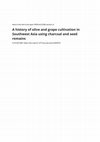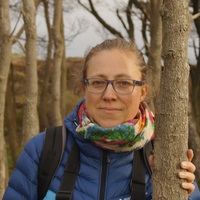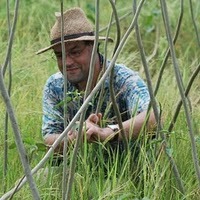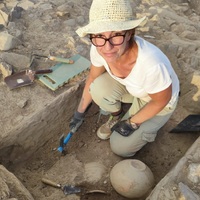Papers by Katleen Deckers
Woodland Use and Agriculture in the Ancient Near East. 20 Years of Archaeobotany at Qatna (Syria). In: Wissing, A., Lange-Weber, S., Geith, E., Glissmann, B., Köster, T., Sconzo, P. (Eds.), Die Kunst des Findens. Festschrift zum 65. Geburtstag von Peter Pfälzner, marru, Münster: Zaphon, 2024. Im Schatten des Despotismus. Die Rolle der Ältesten im Alten Orient nach den Keilschriftquellen d... more Im Schatten des Despotismus. Die Rolle der Ältesten im Alten Orient nach den Keilschriftquellen des 2. Jts. v.
Antiquity, Apr 1, 2024
This project investigates the prehistoric coastal site of Kalba on the Gulf of Oman in the contex... more This project investigates the prehistoric coastal site of Kalba on the Gulf of Oman in the context of exchange networks between maritime waterways and land-based caravan routes on the south-eastern Arabian Peninsula. In addition to favourable environmental conditions, raw-material procurement strategies were important for the economy of this multi-crafting community.

PloS one, Jun 20, 2024
Evaluating archaeobotanical data from over 3.9 million seeds and 124,300 charcoal fragments acros... more Evaluating archaeobotanical data from over 3.9 million seeds and 124,300 charcoal fragments across 330 archaeological site phases in Southwest Asia, we reconstruct the history of olive and grape cultivation spanning a period of 6,000 years. Combining charcoal and seed data enables investigation into both the production and consumption of olive and grape. The earliest indication for olive and grape cultivation appears in the southern Levant around ca. 5000 BC and 4 th millennium BC respectively, although cultivation may have been practiced prior to these dates. Olive and grape cultivation in Southwest Asia was regionally concentrated within the Levant until 600 BC, although there were periodic pushes to the East. Several indications for climate influencing the history of olive and grape cultivation were found, as well as a correlation between periods of high population density and high proportions of olive and grape remains in archaeological sites. While temporal uncertainty prevents a detailed understanding of the causal mechanisms behind these correlations, we suggest that long distance trade in olives, grapes and their associated products was integral to the economic, social, and demographic trajectories of the region.

PLOS ONE, 2024
Evaluating archaeobotanical data from over 3.9 million seeds and 124,300 charcoal fragments acros... more Evaluating archaeobotanical data from over 3.9 million seeds and 124,300 charcoal fragments across 330 archaeological site phases in Southwest Asia, we reconstruct the history of olive and grape cultivation spanning a period of 6,000 years. Combining charcoal and seed data enables investigation into both the production and consumption of olive and grape. The earliest indication for olive and grape cultivation appears in the southern Levant around ca. 5000 BC and 4 th millennium BC respectively, although cultivation may have been practiced prior to these dates. Olive and grape cultivation in Southwest Asia was regionally concentrated within the Levant until 600 BC, although there were periodic pushes to the East. Several indications for climate influencing the history of olive and grape cultivation were found, as well as a correlation between periods of high population density and high proportions of olive and grape remains in archaeological sites. While temporal uncertainty prevents a detailed understanding of the causal mechanisms behind these correlations, we suggest that long distance trade in olives, grapes and their associated products was integral to the economic, social, and demographic trajectories of the region.
H2. Wood identification from charcoal remains. In: H: H. Plant remains from Assur, 2023. In: Karen Radner & Andrea Squitieri (eds.), Assur 2023: Excavations and Other Research in the New Town. Exploring Assur 1. Gladbeck: PeWe-Verlag, 2024
Archaeological and Anthropological Sciences, Oct 23, 2020
This paper presents the macrobotanical record, supported by stable isotope data, from the Halaf (... more This paper presents the macrobotanical record, supported by stable isotope data, from the Halaf (5850-5500 BC) and Late Chalcolithic (c. 4000 BC) occupation of the village Tell Tawila, northern Syria. Drawing on this new data and prior studies of the site, we show that subsistence at Tell Tawila combined agriculture, pastoralism, and foraging, adding it to a growing list of Halaf sites which do not conform to previous established subsistence norms. Furthermore, we argue for an aridification event taking place in the Late Chalcolithic and show how the population at Tell Tawila adapted to this changing climate through increasing exploitations of wild resources.
Radiation Measurements, Aug 1, 2003
In this study we have investigated the apparent dose (D * e) distribution in four samples of youn... more In this study we have investigated the apparent dose (D * e) distribution in four samples of young sedimentary quartz from di erent depositional environments, and on standard quartz comprised of artiÿcial binary-dose mixtures. We have used a simpliÿed two-step single-aliquot regenerative-dose (SAR) approach to rapidly measure D * e from a large number of small aliquots (∼ 50-100 grains), with a small subset subjected to routine SAR measurements to enable monitoring of luminescence characteristics. We have used an F-ratio analysis to interpret D * e distributions. This analysis is sensitive to structure, the leading edge and modal data in D * e distributions, indicated by in ections and plateaux in F-ratio plots. We cautiously suggest that F-ratios at or approaching unity may indicate a single dose component.
Der Königspalast von Qaṭna, Teil 2 Architektur, Stratigraphie, Keramik und Funde des westlichen Zentralbereiches / Eva Geith, Tulip Abd el-Hay, Jochen Schmid ; mit Beiträgen von Peter Pfälzner, Stephanie Döpper, Ivana Puljiz, Tina Köster, Simone Riehl, Emmanuelle Vila, Heike Dohmann, Katleen Deck...

Review of Palaeobotany and Palynology, Jul 1, 2016
Charcoals from archaeological sites in Syria and Turkey have been investigated with a multi-tiere... more Charcoals from archaeological sites in Syria and Turkey have been investigated with a multi-tiered approach to gain insight into the density and composition of the vegetation. The results show that oak woodland occurred further south into northern Syria throughout much of the second half of the Holocene. The data however also shows that the oak woodland may have had some shrub-like appearance, particularly when an intensive phase of urbanization took place in this region during the 3rd millennium BC and pastoral activities were intense. This is indicated by the (in some cases extremely) slow radial growth of oak. Some charcoal fragments also seem to suggest impact on the wood structure from herbivore browsing. Additionally, possibly due to the rather small mass of the oak woodland present dung was being used as an additional fuel source. A pilot carbon stable isotopic study on oak charcoal has been undertaken to reconstruct the climate. The results of this study were considered together with those from previously published studies. At best, moderate correlations were found between the isotopic results and minimal and maximal April temperatures, and between average May and October rainfall and the isotopic values.

Quaternary Research, May 1, 2007
Today the eastern tributaries of the Upper Khabur run dry during the summer and the landscape is ... more Today the eastern tributaries of the Upper Khabur run dry during the summer and the landscape is devoid of trees. This picture is misleading when we try to understand archaeological sites within their former environmental context. Interdisciplinary geomorphological, archaeobotanical and ostracod research on a sequence from the Wadi Jaghjagh indicates that relatively stable, perennial flow velocities occurred during the mid 4th to mid-3rd millennium BC. Evidence was found for a gallery forest and swamp belt along the Jaghjagh during the mid-4th millennium BC. Oak park woodland was present within the region in the 3rd millennium BC and probably up to at least the 3rd century AD. Shortly after 2500 BC, Jaghjagh stream velocities probably decreased or the stream bed had changed its location. Later deposits, possibly dating to the 5th century BC, indicate similar, rather stable flow of the Jaghjagh. More recently however, about ca. AD 900 or afterwards, a flashflood-like regime occurred, which may relate to deforestation. The Wadi Khanzir sediment archives reflect the flashy intermittent regime of this stream, like it still is today, with flashflood evidence dating to the first half of the Holocene and probably dating to approximately AD 400 or later. Along the Jarrah, topsoil was eroded and redeposited by the wadi sometime between 1300 and 600 BC. This may have been caused by the intensive resettlement program of this region around 800 BC. Between about 600 and 300 BC 1.5 m of clay was deposited on the plain.

Paléorient, 2005
: The analysis of more than 24000 charcoal fragments from the Bronze Age layers at Emar allow pal... more : The analysis of more than 24000 charcoal fragments from the Bronze Age layers at Emar allow palaeobotanical reconstructions. The charcoal fragments suggest that during the Bronze Age, the riverine gallery forest was more extensive than today and consisted of a greater variety of taxa, including Populus (poplar)/Sa\ix (willow), Tamarix (tamarisk), Alnus (alder) during the Early Bronze Age, Fraxinus (ash) in Early Bronze Age layers, Platanus (plane) and Ulmus (elm). The discovery of Olea (olive) in Early Bronze Age layers, Vitis vinifera (grapevine) within Late Bronze Age strata and Ficus (fig) wood in Early and Late Bronze Age layers may indicate their cultivation. There is little evidence for the potential Pistacia-a/mowi woodland steppe away from the Euphrates, which suggests that it was probably degraded. Coniferous wood, like Cupressus (cypress), Cedrus (cedar) and Pinus brutia/halepensis (Calabrian/ Aleppo pine) were probably imported. It is of note that pine planks used for Early Byzantine coffins were of a different species than the attested Bronze Age pine fragments.

Journal of Mediterranean Archaeology, Dec 1, 2005
The presence of Medieval and more recent fluvial deposits in the eastern Mediterranean has import... more The presence of Medieval and more recent fluvial deposits in the eastern Mediterranean has important implications for archaeological field survey and for understanding settlement patterns. They may help to explain, for example, why valley floors and terraces are devoid of any sites older than a few centuries. An extensive presence of Medieval and more recent fluvial deposits has been uncovered in western Cyprus as well as in other parts of the Mediterranean. Possible causes are investigated by correlating ‘synchronous’ variables in the landscape that might have had some impact on the fluvial system. Fluvial deposits tentatively dated to the Byzantine period could be a result of the drier conditions. Some deposits, however, suggest anthropogenic influence as well. The widespread river deposition on Cyprus during the Frankish Period was probably caused by wetter conditions, which increased the frequency of overbank flooding. Moreover, increased agricultural production and mining and smelting activities might have triggered erosion and subsequent deposition in the river valleys as indicated at some localities. Fluvial deposition during the Ottoman Period may be correlated with typical ‘Little Ice Age’ climatic conditions

Paléorient, 2008
A dataset of 908 tells, 1823 radial lines and streams in the Upper Khabur Basin was produced by d... more A dataset of 908 tells, 1823 radial lines and streams in the Upper Khabur Basin was produced by digitizing CORONA satellite images. Several analyses are applied to this database in order to understand the hydrological and agrarian contexts of tells that were occupied mainly in the mid 3rd millennium BC. A strong alignment of tell sites along wadis is observed, which may explain the building of settlements upwards. The analysis of radial lines with exaggerated 3D-SRTM data indicates that, in most cases, they are unlikely to have been used as an irrigation system, but rather may be hollow ways with sometimes fade-out points delineating the end of cultivation zones. This is supported by a comparison between cultivation zones based on hollow ways and calculations of the necessary amount of land starting from the tell sizes. Resource exploitation calculations indicate that the area was not overexploited during the mid 3rd millennium BC and that tribute ca 2300 BC may have been a reason for land overexploitation, perhaps playing a role in settlement disruptions between 2200 and 1900 BC.
Zeitschrift Fur Geomorphologie, Jul 1, 2014
Geoarchaeology-an International Journal, 2004
Abstract In this paper, simple thermoluminescence (TL) dating procedures utilizing non-diagnostic... more Abstract In this paper, simple thermoluminescence (TL) dating procedures utilizing non-diagnostic sherds from fluvial deposits are described. This approach may provide preliminary insights into the chronology of fluvial sequences in areas where transported ...
Cambridge Scholars Publishing eBooks, 2007
This presentation will summarise anthracological results from northern Syria for the second half ... more This presentation will summarise anthracological results from northern Syria for the second half of the Holocene. A combination of methods will be used to investigate the relative impact of people and climate on the vegetation.











Uploads
Papers by Katleen Deckers